BLOG
Fall Snook Fishing
The start of the fall season in South Florida doesn’t come with falling leaves or dropping temperatures like the rest of the country. Instead, its marked by the start of Snook season. You can always tell when Snook season starts by the zombie like appearance of guys/gals on their third trip back from the coffee maker at work. Success can certainly be had during the day but for a large percentage of anglers Snook fishing is a night or pre-dawn game. Snook are very active at night throughout all phases of the moon and can be targeted with a variety of techniques. This write-up focuses on hard bait techniques for night fishing, particularly around structure like bridges and jetties.
The fall snook season, particularly on the east coast of Florida, can be broken down into three phases: pre-mullet run, mullet run and post mullet run. Each phase offers its own unique challenges and opportunities.
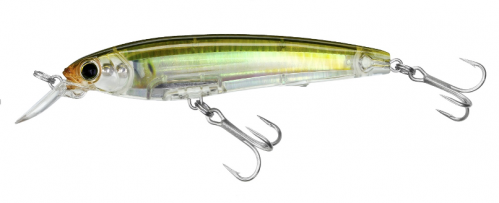
The pre-mullet phase typically features very hot and humid nights, with a limited amount of wind and the fish are often keyed in on small bait like sardines, pilchards and glass minnows. There is always resident mullet but not the giant schools you see during the mullet run. The challenge for this time of year is getting fish to bite that are keyed in on smaller profile bait, often in still and clear water conditions. One of my favorite baits for this time of year is the Yo-Zuri 3D Inshore Fingerling in the 4 inch (100mm) size. This bait was introduced at ICAST 2021 but was modeled with the exact same action and body design of the 3DS Minnow 100. The 3DS Minnow is a bait that has caught hundreds of thousands of Snook and been a favorite of fisherman for 10+ years. The issue was the hooks and split rings were designed for freshwater and needed to be switched out. The new 3D Inshore Fingerling comes with full saltwater terminal tackle that can handle most fishing conditions and Snook into the 40+ inch range. The Fingerling is especially effective at this time of year for a couple reasons. One its at the top end but not outside, the typical bait size for this part of the season. It has a shape similar to a sardine, and is close enough to the size of a small pilchard or glass minnow. It has a very tight swimming action that mirrors the swimming pattern of these prey species. The third and most unique feature of this bait is the diamond shaped lip. For land-based anglers like me this is extremely important. The first thing you notice with this bait is it stays in the water all the way back to your rod tip even when fishing from an elevated position.
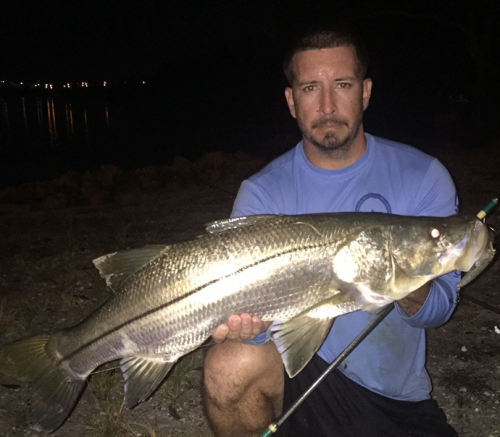
One of my favorite places to fish this bait is at the bridges along the shadow lines where snook wait to ambush prey. Get on the up current side of the bridge and cast out into the light away from the bridge at roughly a 45-degree angle. Slowly retrieve the plug and let it swing into the shadow line with the current. The key is to get the bait to come into the Snook face right on or just outside (within 6 inches) of the shadow line. The angle of your cast will need to be adjusted based on the where in the phase of the tide you are/the speed of the current. For most of the tide a 45 degree cast is best but near the slack phase you can cast 6 to 12 inches outside the shadow line and work it down the edge of the line. Because the 3D Inshore Fingerling stays in the water longer than other lipped minnow baits, it allows you to cover more of the shadow line on each cast and I have caught fish that were sitting within a couple feet of where I am standing. Another great location for fishing this bait is along the rocks at the jetties. Early season Snook tend to be very close to the rocks at the jetty. Unlike other baits that come up and out of the water close to the jetty the Fingerling stays in the water all the way up to the rocks and many of the bites come with the leader in the rod tip.
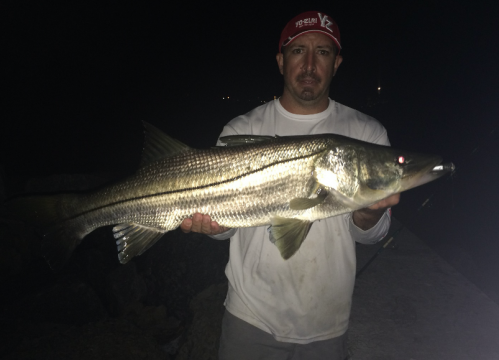
Recommended tackle for the Yo-Zuri 3D Inshore Fingerling is a 7 to 9ft rod in the 15-30lb class, with 30 or 40lb Yo-Zuri SuperBraid and 40lb TopKnot fluorocarbon leader. This tackle is light enough to throw a four-inch plug but still allows you enough strength to pull fish away from structure. One tip I would give is trying white braid for night fishing. The white braid allows you better visibility on the angle of your line and since it’s the raw form of braid it never fades. I choose TopKnot Fluorocarbon for the Fingerling because it has a very thin diameter which allows the plug to have a better swimming action while still giving you the strength and abrasion resistance to land fish in tight spaces between rocks or pilings. My color selection for this bait and time of year tends to be as realistic as possible with top colors being Real Pilchard, Ayu, Peanut Bunker or on full moon nights Ghost Shad. I like a green or olive bait with light sides because it mirrors the color patterns of Sardines and Pilchards, two of the main prey species in early September.
The second phase of the fall snook season is the start of the mullet run. This yearly occurrence is truly a National Geographic level event that has to be seen with your own eyes to appreciate. The mullet schools can be found during the day but its at night when the real fireworks go off. The key with fishing the mullet run is finding areas where the Snook stage and wait on the waves of schools of mullet to come through. Snook will feed on mullet in open water but without structure to isolate your lure it becomes an extremely frustrating needle in a haystack scenario. Two of the most common areas for Snook to stage during the run are again shadow lines at bridges and the rock jetties at inlets. Figuring where the large concentrations are going to be at each stage of the tide is key for putting yourself in the best possible position to capitalize on your opportunities. Where and when can differ from bridge to bridge and jetty to jetty and you simply have to put your time in to figure out the pattern.
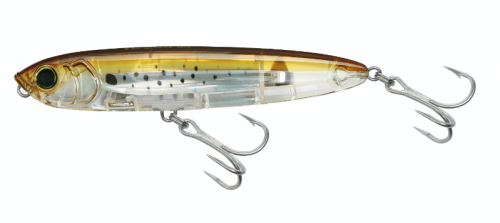
A couple of my favorite baits for fishing the mullet run at night are a pencil bait, either the 3D Inshore TopKnock Pencil 130 or the Hydro Pencil, and the Mag Darter. If I can get them to feed on it the topwater is my first choice because it’s the most enjoyable. The sound, feel and visual of a big Snook blowing up a topwater on a shadow line still gives me goosebumps just thinking about it, despite seeing it thousands of times over the last 30 years. The time when pencil baits are most effective is during the mullet run when Snook are popping mullet on the up current shadow line of the bridge. There are two main presentations that I have learned over the years. The first is a casting at a 45 degree angle into the light and having a slow and steady retrieve, no walking, as the current swings the bait into the shadow line. The plug will make a V in the water that looks very similar to the V that a mullet makes swimming along the surface. The other technique is to cast out into the light at a 45 angle or even straight out into the light and reeling very fast until the bait nears the shadow line, at which time you dead stick it. The plug will skip across the surface right up to the shadow line and then pause and float with the current into the shadow. This mirrors the action of mullet, which move very quickly in the light and tend to freeze when they hit a shadow line. The key with both techniques is to make sure the bait hits the shadow line right on the nose of the fish you’re targeting. Snook don’t want to move more than a couple inches to eat baits during the run because they don’t need to with millions of mullet pouring through the bridge.
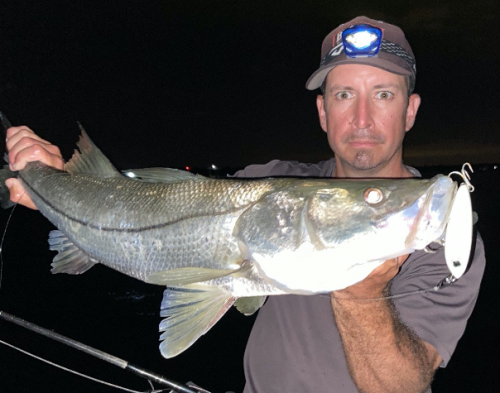
An under-utilized technique is fishing pencil baits at the jetty at night. It can be extremely frustrating fishing a swimming plug through millions of mullet on the beach side of jetties and watching explosion after explosion without a bite. When Snook are popping mullet on top you can make long casts over the school of bait and real in the plug with a slow and straight retrieve. Your plug will often part the school of mullet, isolating your bait and resulting in grenade like explosions. When using this technique make sure to real the plug all way back to the rock you are standing on as many of Snook wait for mullet to pin against the rocks making them easier to catch. Whether you’re fishing the bridge or the jetty with a pencil bait one of the most important things to remember is don’t react to the visual of the bite. Reel through the bite and let the rod start to load up with the weight of the fish before setting the hook. This is extremely important when fishing from an elevated position and will increase your hook up ratio and limit the number of times the plug comes flying back at your head (or the person next to you).
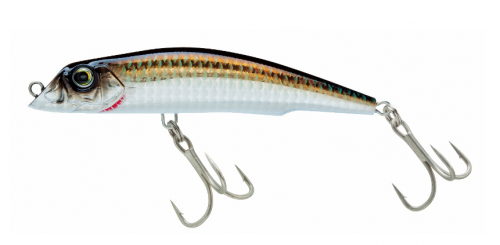
There are certain times during the mullet run when a swimming plug can be more effective than topwater. Its at these times that I turn to the Mag Darter. Darters are a northeast style bait used for targeting Striped Bass in the surf, back bays or on rips. There is no lip, instead the slanted head acts as the lip and gives the bait its action. Some darters are designed to dart side to side only with very little swimming action. That action works in certain situations for Striped Bass up north and Tarpon in Florida but is less effective on Snook. The Yo-Zuri Mag Darter is a swimming style darter that has a moderately wide swimming action and every few feet darts a few inches to one side or another. The action is extremely close to that of a scared mullet at night. The key for fishing this bait is fishing it cross current or against the current, when fished with the current it has very little action. One of my favorite places to throw this bait is from the side of the bridge on the up current side. You can stand on the seawall on the side of the bridge or anchor your boat outside the shadow line and cast out into light. A slow to moderate steady retrieve while letting the current swing your bait up against or just into (not more than 6 inches) the shadow line is most effective. You can adjust your retrieve speed and the angle of your position to make the bait travel in the perfect zone, 6 inches inside or outside the shadow line, down a large area of the bridge. That allows you to present the bait to large number of Snook and increases your chances of a bite. The Mag Darter is also effective when anchored or standing outside the shadow line and casting back into the dark and slow retrieving it out towards the shadow line. When fishing that technique, you can pause it in that key strike zone and let the current give the bait action, keeping your bait in the strike zone longer.
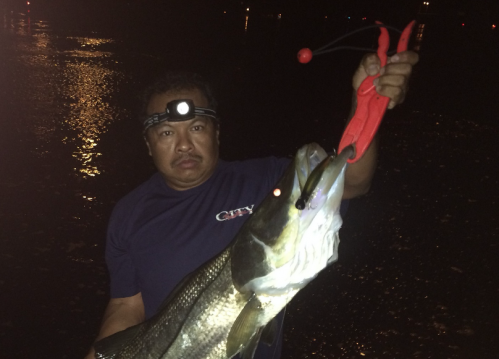
The Mag Darter is also very effective at the jetty. The main technique at most jetties is throwing it extremely close along the edge of the rocks and working it back slowly against the current. The darter doesn’t have a plastic lip to break so you can bounce it off the edges of the rocks without damaging it and get reaction bites that other baits don’t get. The patented magnetic weight transfer system in the Yo-Zuri darter gives you ability to make very long and extremely accurate casts. This is especially key fishing the jetty during the mullet run because the timing often coincides with Tropical Storms, Hurricanes and large northeast swells. The Mag Darter is very effective in crashing waves and white wash at the jetty where Snook feed on disoriented baitfish. In those conditions it stays in the water better than typical lipped plugs.
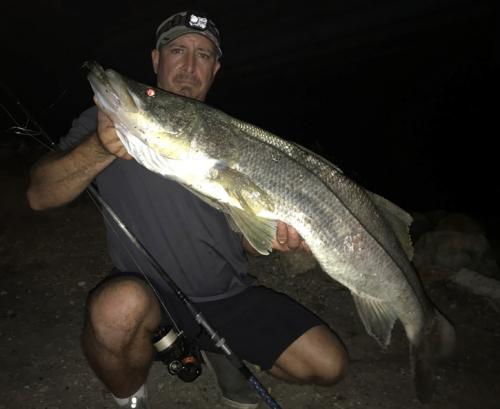
Tackle for fishing the Mag Darter, 3D Inshore TopKnock Pencil or Hydro Pencil in the mullet run is an 8 or 9ft rod with 40lb SuperBraid and 60lb HD Fluorocarbon leader. You need the heavier leader because 40+ inch fish are a real possibility and although the plug gives you some protection, they will choke it sometimes and the 60lb helps you from getting frayed off. The color selection for topwaters for the mullet run is very simple for me, either Bronze (Peanut Bunker) or Bone. I use either the bronze Hydro Pencil or the Peanut Bunker TopKnock 90% of the time. Bone is what I use on full moon or near full moon nights. The silhouette of the Bone pencil works well with a bright moon but on darker nights the nature bronze patterns are most effective. The pencil baits from Yo-Zuri come with 3X strength treble hooks that don’t need to be switched out and very importantly have only a single one knock cadence rattle, which is much more effective on Snook than baits with multiple loud BB rattles. My color patterns for the Mag Darter are very natural, either Bronze or Bronze Shiner.
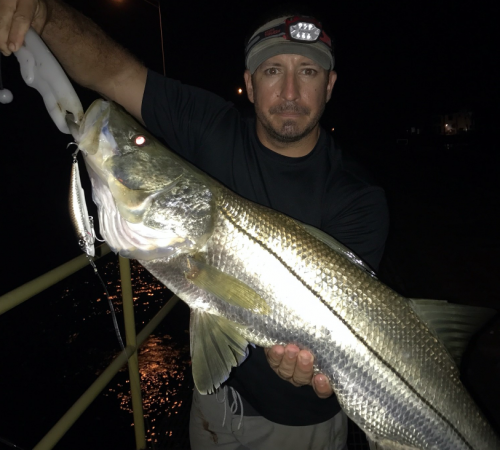
The third phase of the fall snook season is marked by the arrival of strong cold fronts and the end of the mullet run. There are still opportunities for catching fish on topwaters and swimming plugs when you find the right conditions but this is the time of the year when flair hawks and paddle tail swimbaits become most effective. The water temps start to drop and fish begin moving to deeper holes at the bridges or out onto the ledges at the inlets. The key for this time of the season is keeping your bait as close to the bottom as possible, low and slow is the name of the game.
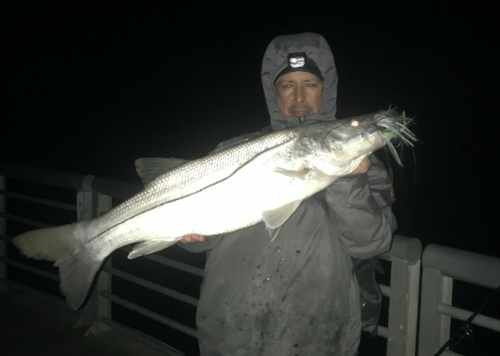
You can find quality flair hawk jigs at any local tackle shop from Miami to Melbourne on the east coast and up through Tampa on the west coast. They are a nylon jig with a longer bottom “tail” that comes in a variety of colors and sizes. For most applications the 1.5 oz size is best but in deeper water or heavier current a 2oz or even 3oz may be needed. In light current situations I tend to “swim” the jig cross current with a slow steady retrieve. In high current situations I tend to bounce the jig on the bottom cross current to ensure I stay in the strike zone and don’t get the jig up too high. My favorite colors for Snook are white body/green tail, white body/black tail, white body/blue tail or chartreuse body/blue tail. I tend to use white in cleaner water conditions and chartreuse on darker nights and darker water. Color isn’t as important as making sure you’re putting the jig in front of the fish on a consistent and repeated basis. At some jetties you can plan on losing a lot of jigs so be prepared to retie a lot, its just part of jig fishing. Paddle tail swim baits on 1.5-3oz jig heads can also be extremely effective this time of year. These are fished is similar locations, along the bottom at the bridge or jetty, and with similar techniques. There are several companies, local and national, making quality versions of this style bait. Color selection varies from person to person on their favorite and I have caught fish on everything from white, to lime green and orange or even dark purple. Jigs and swimbaits are pretty much all I throw after the mullet run ends but I also throw them from time to time during or even before the mullet run. One of my favorite times to throw them is during the mullet run under big silver mullet or black mullet schools. When the mullet are 8-15 inches or more a keeper Snook can eat them but they have to work for it. They tend to sit under the bait school and come up to ambush their prey rather than sitting on top on the shadow line like they do in finger mullet or smaller silver mullet (6-8inch) schools. During these conditions a jig or swimbait swam along the bottom into their face can be very effective and catch some of the biggest fish of the year.
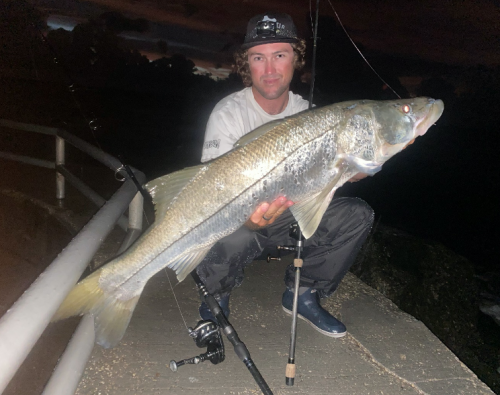
For jig or swimbait fishing I throw a 9ft rod, again with 40lb white Yo-Zuri SuperBraid and 80lb Yo-Zuri TopKnot or HD Fluorocarbon. Snook choke the jig or swimbait a lot and many times you’re trying to bring them up over a ledge so the heavy fluorocarbon leader is very important. Also, these baits tend to get a lot of 40+ inch fish in heavy current. Long casts are key, especially at the jetty so I don’t like to go above 40lb braid because you begin to lose casting distance.
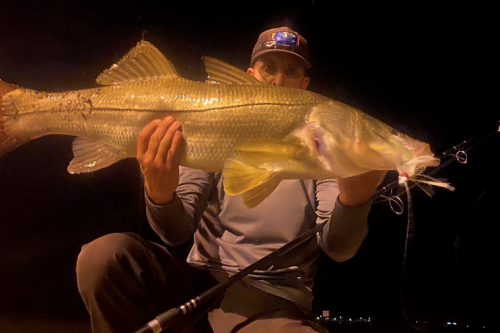
Hope this article helps you have a more successful fall Snook season this year. See you out there!
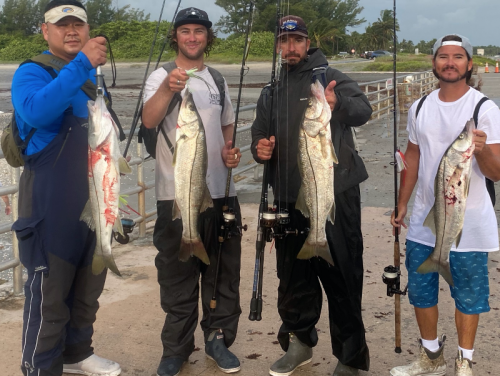
Christopher Bishop (Junochris)
